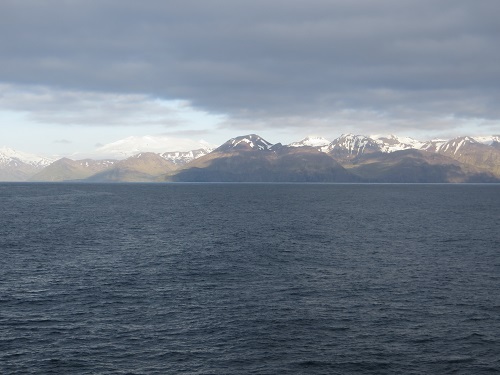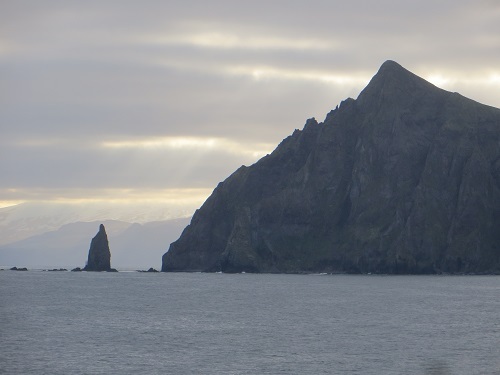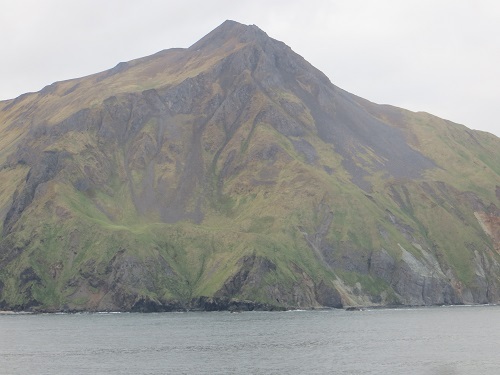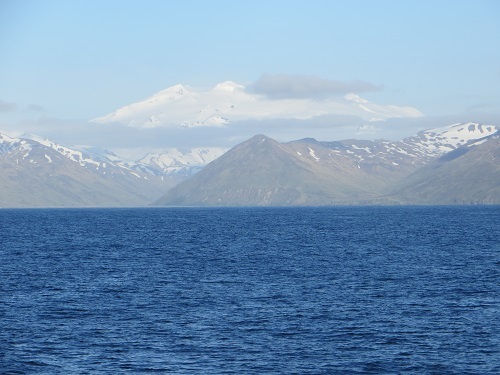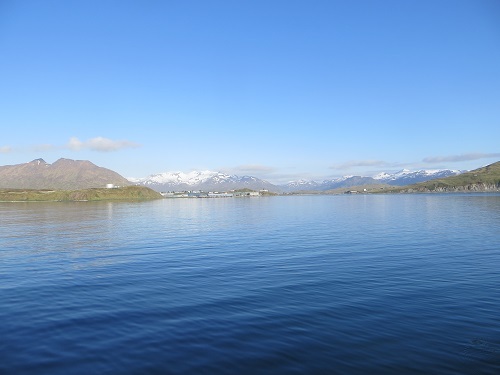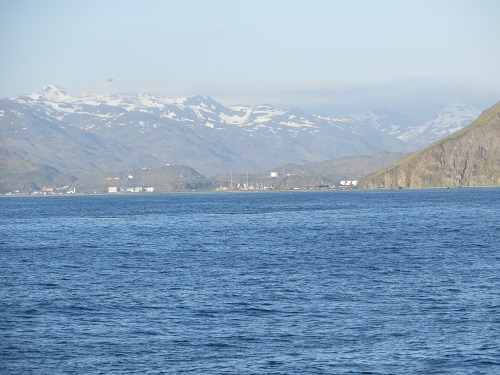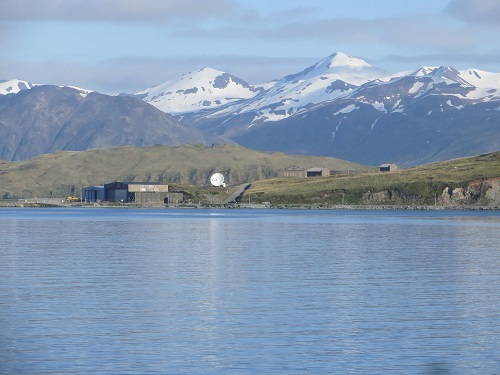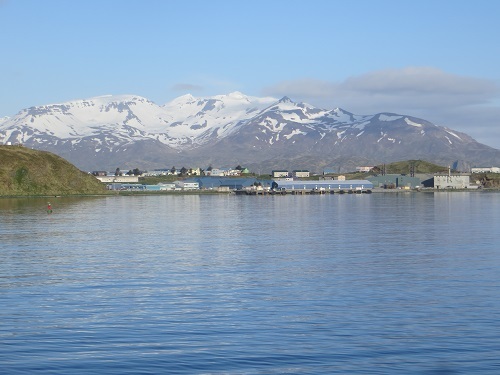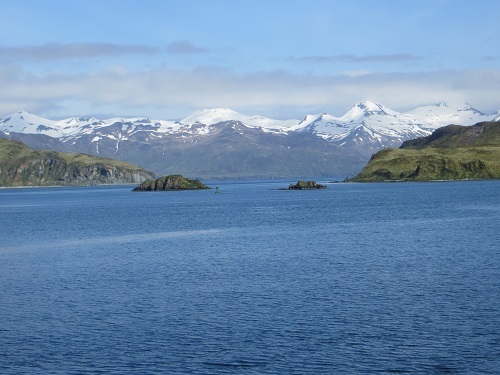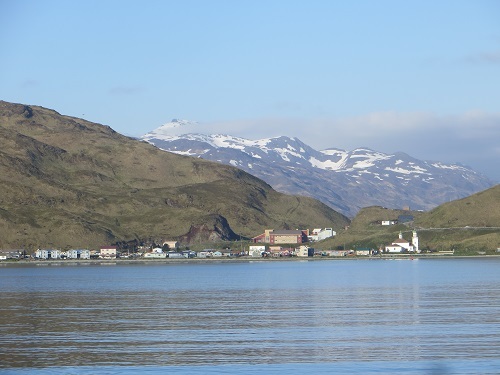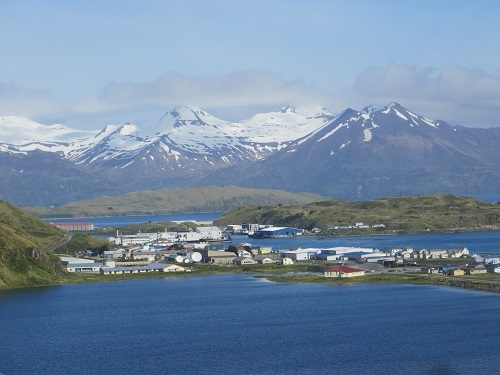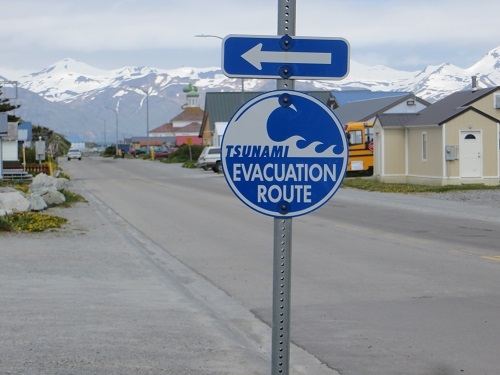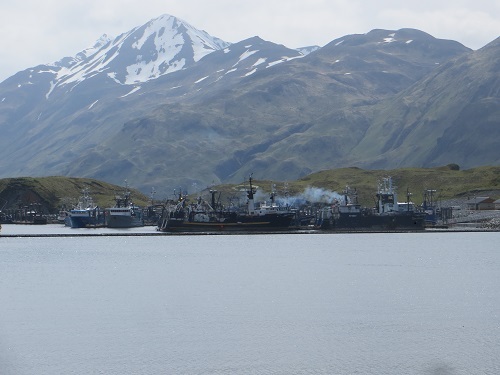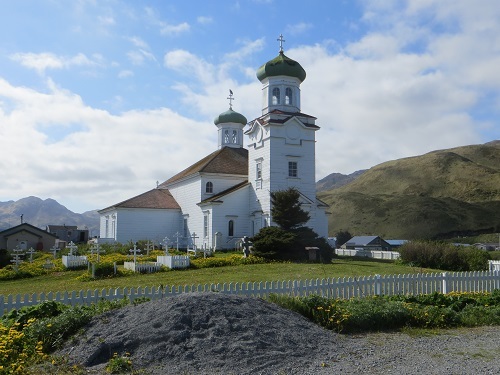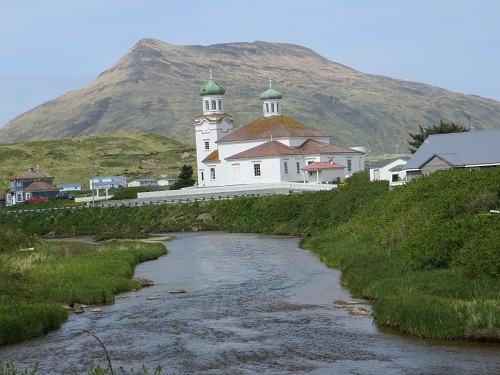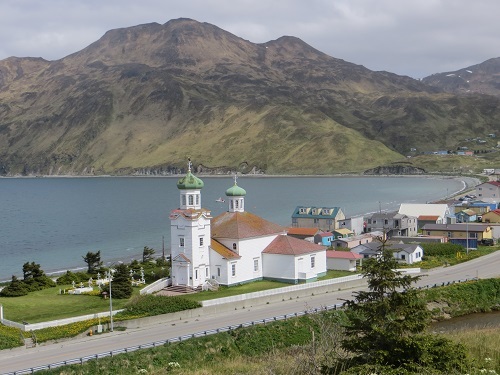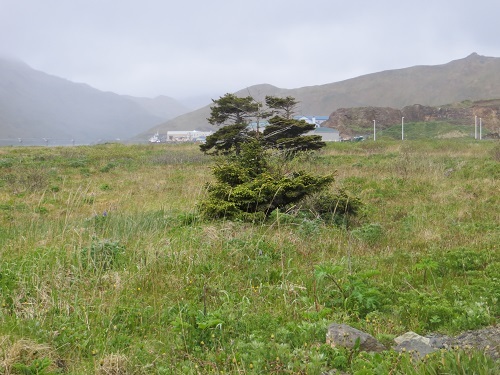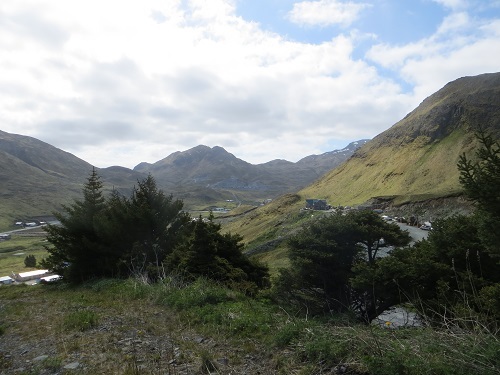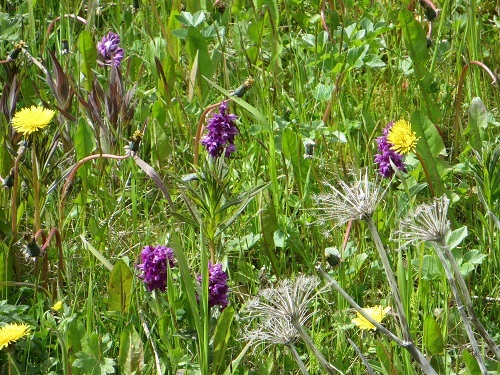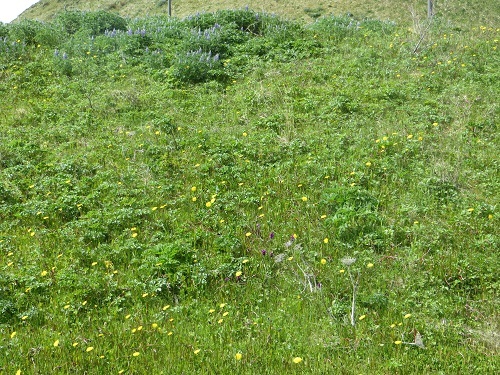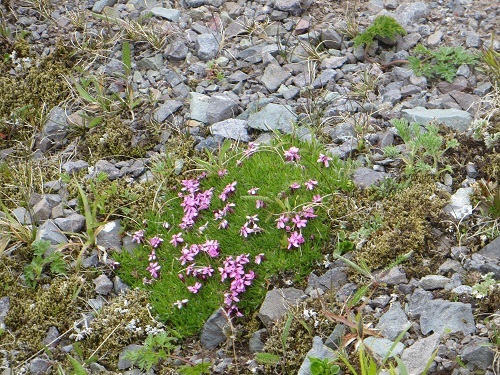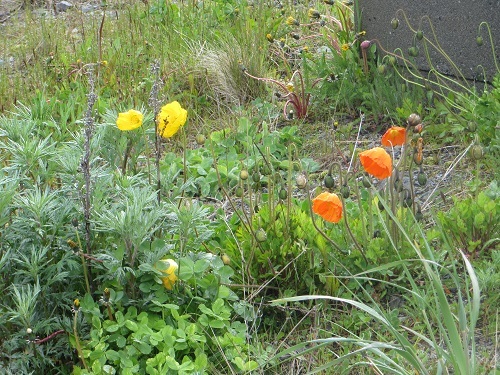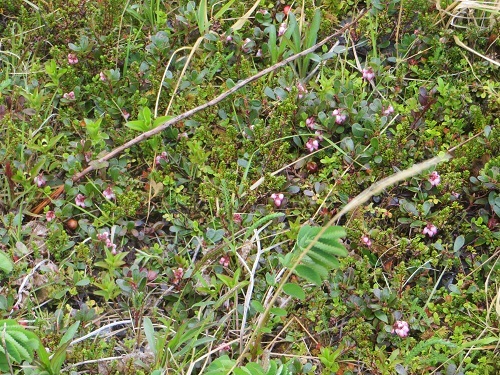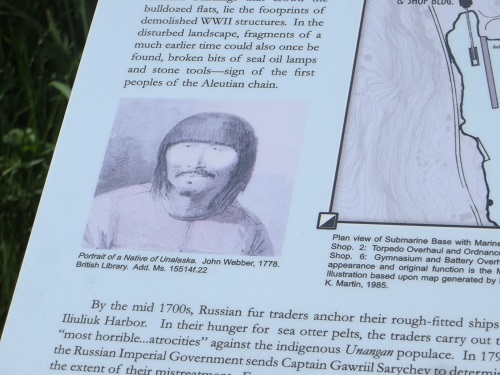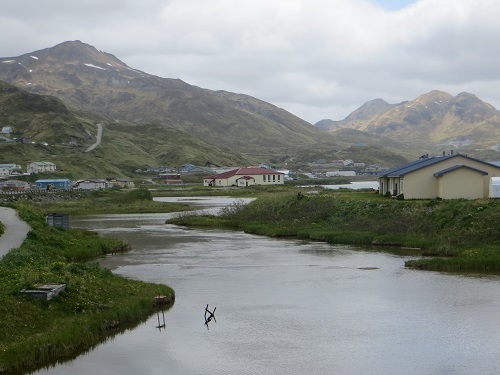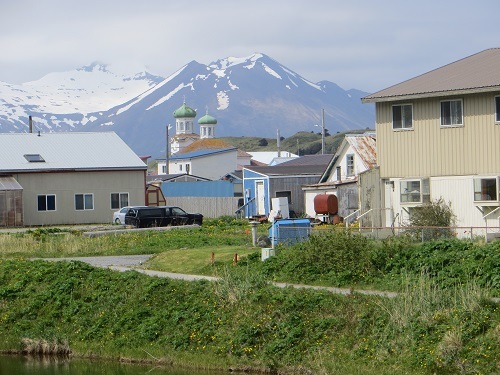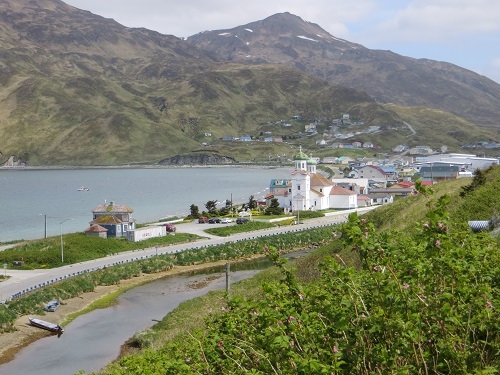We arrive in Dutch Harbor on Unalaska, the main Aleutian island, in glorious sunshine, right on the dot - three days, 10 hours and 45 minutes after leaving Homer, even if a little rock'n'rolling sent Yours Truly rushing for the Dramamine during the night - twice.
The captain announces that we even have enough time to let one of the crew members practice a 360 degree turn. And here we go, facing the harbor mouth again. Oops, we just miss that rock over there.
Views on approaching Unalaska
Interestingly, many passengers, including the vulture-nosed birder and his fellow birds of a feather, are going straight back on the Tustumena when she leaves in eight hours' time, instead of staying here a few days and taking a daily 3 ½-hour-flight to Anchorage.
Now that makes sense for two Aleuts who got on at Akutan Island, three and a half hours ago. They're on a beer run, since the only bar there closed due to rent problems and they're planning a major haul here. But to spend another three and a half days to see the same places we've just seen, even if you are beak-nosed birder...
More views
Needless to say, Unalaska is spectacular, fractured by inlets and fjords that plunge deep into its sage-green cliffs. The peaks are streaked with snow and ice, and the highest, 5,906-foot Makushin Volcano, is draped in brilliant white. It erupted most recently 20 years ago.
There's said to be a fluorescent blue pond in its crater but I have no intention of spending a day and a half climbing to prove it.
Getting closer
Besides, the varying green hues that dust this deeply crumpled land, the white of the mountain tops, the blue of the sea and inlets and the deep purple, iridescent blue, blushing pink, rich carmine and golden yellow of the myriad little flower are more than enough for my palette.
Drawing into port
Unalaska is the name of both the main island and the town, a russification of the Unangan (Aleut) word Agunalaksh, meaning close the mainland. The Russians called the harbor, sheltered by Amaknak Island that almost touches Unalaska at its closest, Dutch Harbor. A Dutch ship apparently anchored there in the late 1700s and the name has stuck.
For the Aleuts their islands are the 'cradle of the winds,' whose fierceness, one of the reasons there are virtually no trees in the 100-island, 1,250-mile arc, is spawned by their being the rendez-vous point of the Bering Sea's cold Arctic air and the north Pacific's warmer temperatures.
Unalaska/Dutch Harbor is a not unattractive little village spread over tongues of land lapping round inlets and bays on both Unalaska and Amaknak islands, joined by a series of short bridges.
It's the No:1 fishing port in the U.S. for seafood landings and, as already noted, home base for the fishermen who risk their lives in the reality TV show, Deadliest Catch, by venturing out into the storm-tossed Bering Sea in some of the most ferocious waters on Earth.
Despite the eyesores of industrial fishing warehouses and equipment, it is greatly enhanced by its spectacular location. Steep sage-green dusted hills and craggy ice-capped peaks appear at every turn - and at every turn tsunami evacuation route signs with crashing blue waves warn you of the equipment in Mother Nature's arsenal.
As well as fishing, Unalaska is a major staging area for Shell's oil exploration in the Bering, Chukchi and Beaufort seas, with ships mooring at several little harbours in its various bays and inlets.
Its most famous sight is the little Russian Orthodox cathedral with twin green onion domes on a harbour headland. The oldest cruciform-style Orthodox church in North America, it was completed in 1896. Listed as one of the 12 most endangered historic landmarks in the world in the 1970s, it has since undergone serious restoration.
In addition to the green hills and snow-capped peaks, the red, green and blue roofs of the buildings behind it and their blue and grey sides provide a great backdrop.
A few trees sprout here and there - Sitka spruce planted by the Russians in 1805 in Sitka Spruce Park. Only one rises high but it hardly looks like a spruce, being bare until the very top. The others are stunted. A few were also planted by nostalgic U.S. troops during WWII.
But plenty of flowers
Aleuts lived on this island chain for 9,000 years, according to archaeological finds, eking out a life in the harsh climate in apparent happiness and relative harmony until greedy Russian fur traders in the 1740s discovered the cornucopia of sea otters and other animals whose skins they coveted.
They treated the Aleuts like shit, enslaving them to hunt for the skins, and the locals' numbers fell victim to harsh treatment and European diseases like smallpox. From 25,000 in the mid-18th century the population plummetted to 2,000 a century later.
But, amazingly enough, they were saved by Russian Orthodox priests, especially Ioann Veniaminov who valued their culture and helped preserve it together with their language. They intermarried with Russians and were treated without discrimination.
Views around town
But when Alaska was sold to the U.S. in 1867, the Americans treated them much worse than the Russians, despising their culture, banning their language and taking their children away from them to be 'Americanised' in boarding schools. Discrimination in the form of Americanisation had arrived with a vengeance.
There are now 8,000 people in the Aleutians, only a small percentage having Aleut blood. There are many Vietnamese, Koreans and Filipinos who have come here to work, given the high wages, and also several thousand seasonal workers in the fishing industry.
It's not too cold here. The relative mean winter temperature is 36 Fahrenheit, and that for summer 55, although it can reach minus 2 and 80 respectively. It's the winds coming through from the Bering Sea on the islands' north shores that are extreme, sometimes reaching 100 miles per hour.
They are known as 'williwaw,' a word of unknown origin first used by 19th century British sailors to describe sudden violent colds in the Aleutians and the Strait of Magellan, giving full significance to the Aleutians' description of their home as 'cradle of winds.' It's also the name of Gore Vidal's first novel, about a ship in the Aleutians.
But, as they say here: dress in layers, there's no bad weather, just bad clothes. Today (early June), even if the sun's not out and it's cloudy, the clouds are high, the winds are low, and the land is bright.
[Upcoming blog on Sunday: The eagle has landed - real-life eagles and the relics of war in the Aleutians]
______________
By the same author: Bussing The Amazon: On The Road With The Accidental Journalist, available with free excerpts on Kindle and in print version on Amazon.
Swimming With Fidel: The Toils Of An Accidental Journalist, available on Kindle, with free excerpts here, and in print version on Amazon in the U.S here.
